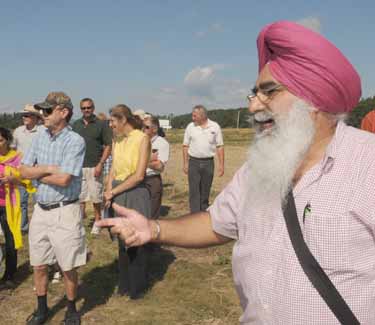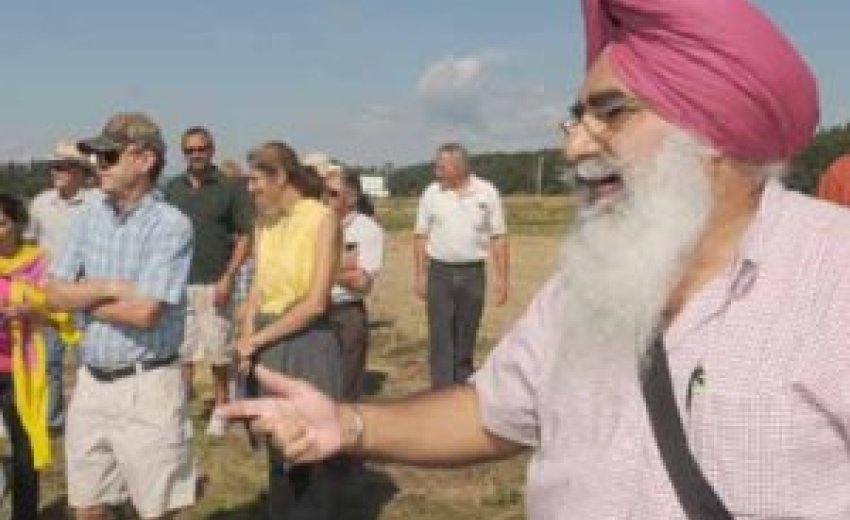Two new crops have area farmers excited.
 |
| Tarlok Singh Sahota of the Thunder Bay Agricultural Research Station leads a tour of the facility with area farmers Thursday morning. (Brent Linton) |
The event was hosted by the Thunder Bay Soil and Crop Improvement Association and the research station.
The station is constantly experimenting with new strains of seeds and fertilizers to see what works best in the region‘s climate, and to introduce producers to new crops and techniques.
Tarlok Singh Sahota, director of research and business at the station, said the station‘s role is to experiment with different types of crops and fertilizers to see not only if they will survive, but how they will benefit all agricultural businesses in the area.
“Years ago there were only a handful of crops grown in the area, because there wasn‘t a lot of research being done on adapting and introducing new strains,” Sahota said in an interview. “Our work has allowed for the introduction of new crops, many that we thought would never thrive in the northern climates.”
Sahota said several factors have to taken into account when experimenting with new crops – soil conditions, humidity, length of growing season and precipitation among them. Innovation across the country, he added, has created numerous new breeds of crops that can grow in unexpected places.
The station features hundreds of small plots where researchers monitor the progress of everything from flax to dozens of species of wheat and corn.
The new crops that interest Sahota are a new breed of alfalfa and legumes, which are being grown in Thunder Bay for the first time.
“I‘m very excited to see legumes doing well in our climate because they present many positive avenues for farmers,” Sahota said. “Per serving, they provide 36 per cent of daily fiber, high in iron and selenium, and are easy to cook and store.
“For farming, they are excellent nitrogen trappers, pulling nitrogen out of the air and holding it in the soil, allowing farmers to save time and money on fertilizing fields.”
The alfalfa strain has been modified to increase its protein content by up to three per cent, making it a nutritious forage crop for cattle. In turn, the cattle are healthier and their waste has more nutrients, making it a better fertilizer.
The station also experiments with different mixes of fertilizer.
Sahota said traditional mixes had three components, nitrogen, potassium and potash.
“We‘ve found through experiments there needs to be more than those three, sometimes up to 12 other nutrients, like boron and lye to create a better, more sustainable balance,” he said.
Research also tries to find ways to make farming more localized, by sourcing materials, like fertilizer components, from local industries such as logging.
Growing food isn‘t the only activity at the station.
Solar power generation was featured Thursday in a presentation by Helmut Spieser of the Ministry of Agriculture, Food and Rural Affairs.
Solar power, Spieser said, is a viable and economical way for producers to make more money off the land.
“It‘s another way for them to make a profit if they want to set up a panel array, whether it be one of these MicroFit, ground fixed arrays or one that tracks the sun,” he explained. “I do have to explain it‘s a two-metered system, one that tracks how much they are making and selling back to the grid, then there‘s what they are using and buying.”
The need for a research station is critical to make farming in the north viable, said Peggy Brekveld of the Thunder Bay Federation of Agriculture, who added events like the open house show the importance of developing locally sourced farm products.
"It wasn‘t long ago we couldn‘t grow corn here because there wasn‘t enough rain units," said Brekveld. "Now with research like this, there‘s corn in Thunder Bay, which is vital to the local dairy industry."
“It‘s also about education, showing the public why we need to have a diverse, local source of food, because the demand for local food is growing and in a worst-case scenario, we may need to rely on local growers to feed our communities.”
